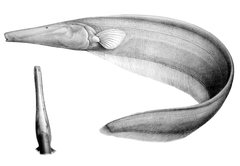Ghost knifefish
| Ghost knifefishes | |
|---|---|
 | |
| Black ghost knifefish (Apteronotus albifrons) | |
| Scientific classification | |
| Kingdom: | Animalia |
| Phylum: | Chordata |
| Class: | Actinopterygii |
| Order: | Gymnotiformes |
| Family: | Apteronotidae D. S. Jordan, 1923 |
The ghost knifefishes are a family, Apteronotidae, of ray-finned fishes in the order Gymnotiformes. These fish can be found in the freshwater of Panama and South America.[1]
They are distinguished from other gymnotiform fishes by the presence of a caudal fin (all other families lack a caudal fin) as well as a fleshy dorsal organ represented by a longitudinal strip along the dorsal midline.[1] They vary greatly in size, ranging from about 15 cm (6 in) in total length in the smallest species to 60 cm (2 ft) in the largest.[2] It has been claimed that Apteronotus magdalenensis is up to 130 cm (4.3 ft),[1] but this is not supported by recent studies, which indicate that it does not surpass about 50 cm (1.6 ft).[2][3] These nocturnal fish have small eyes.[4] Also, sexual dimorphism exists in some genera in snout shape and jaws.[4]
Apteronotids use a high frequency tone-type (also called wave-type) electric organ discharge (EOD) to communicate.[4]
Many Apteronotids are aggressive predators of small aquatic insect larvae and fishes, though there are also piscivorous and planktivorous species. Sternarchella spp. are very unusual, preying on the tails of other electric fishes. Other species, such as Sternarchorhynchus and Sternarchorhamphus, have tubular snouts and forage on the beds of aquatic insect larvae and other small animals which burrow into the river bottom. At least one species (Sternarchogiton nattereri) eats freshwater sponges which grow on submerged trees, stumps, and other woody debris. The genus Apteronotus is artificial and some of the species do not actually belong in it.
The black ghost knifefish (Apteronotus albifrons) and brown ghost knifefish (Apteronotus leptorhynchus) are readily available as aquarium fish. Others are known to appear in the trade but are quite rare.
Species
FishBase lists 89 species in 15 genera,[4] while a comprehensive review in 2017 listed 93 species in 14 genera (the result of Magosternarchus being subsumed into Sternarchella),[5] and this is followed by Catalog of Fishes.[6] A number of species have been discovered and described recently.[7][8]
- Genus Adontosternarchus
- Genus Apteronotus
- Genus Compsaraia
- Genus Megadontognathus
- Genus Melanosternarchus
- Genus Orthosternarchus
- Genus Parapteronotus
- Genus Pariosternarchus
- Genus Platyurosternarchus
- Genus Porotergus
- Genus Sternarchella
- Genus Sternarchogiton
- Genus Sternarchorhamphus
- Genus Sternarchorhynchus
- Genus Tembeassu
References
- 1 2 3 Nelson, Joseph, S. (2006). Fishes of the World. John Wiley & Sons, Inc. ISBN 0-471-25031-7.
- 1 2 van der Sleen, P.; J.S. Albert, eds. (2017). Field Guide to the Fishes of the Amazon, Orinoco, and Guianas. Princeton University Press. pp. 322–330. ISBN 978-0691170749.
- ↑ Maldonado-Ocampo, J.A.; Santana, C.D. de; W.G.R. Crampton (2011). "On Apteronotus magdalenensis (Miles, 1945) (Gymnotiformes: Apteronotidae): a poorly known species endemic to the río Magdalena basin, Colombia". Neotrop. Ichthyol. 9 (3). doi:10.1590/S1679-62252011000300005.
- 1 2 3 4 Froese, Rainer, and Daniel Pauly, eds. (2017). "Apteronotidae" in FishBase. October 2017 version.
- ↑ Ferraris Jr, C.J.; C.D. de Santana; R.P. Vari (2017). "Checklist of Gymnotiformes (Osteichthyes: Ostariophysi) and catalogue of primary types". Neotrop. Ichthyol. 15 (1). doi:10.1590/1982-0224-20160067.
- ↑ Eschmeyer, W.N.; R. Fricke; R. van der Laan (12 May 2018). "Catalog of Fishes". California Academy of Sciences. Retrieved 12 May 2018.
- ↑ de Santana, C.D. & Vari, R.P. (2010): New Rheophilic Species of Electric Knifefish from the Rapids and Waterfalls of the Lower Rio Xingu, Brazil (Gymnotiformes: Apteronotidae). Copeia, 2010 (1): 160-164.
- ↑ Evans, K.M.; W.G.R. Crampton; J.S. Albert (2017). "Taxonomic revision of the deep channel electric fish genus Sternarchella (Teleostei: Gymnotiformes: Apteronotidae), with descriptions of two new species". Neotropical Ichthyology. 15 (2): e160168. doi:10.1590/1982-0224-20160168.
